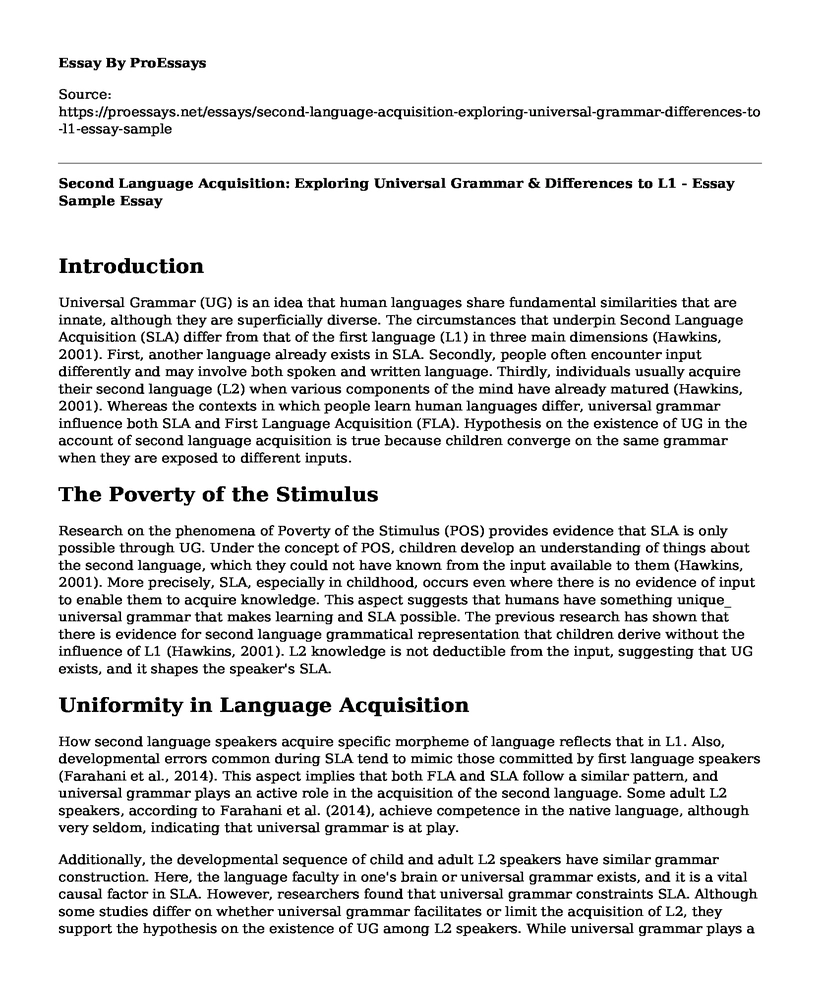Introduction
Universal Grammar (UG) is an idea that human languages share fundamental similarities that are innate, although they are superficially diverse. The circumstances that underpin Second Language Acquisition (SLA) differ from that of the first language (L1) in three main dimensions (Hawkins, 2001). First, another language already exists in SLA. Secondly, people often encounter input differently and may involve both spoken and written language. Thirdly, individuals usually acquire their second language (L2) when various components of the mind have already matured (Hawkins, 2001). Whereas the contexts in which people learn human languages differ, universal grammar influence both SLA and First Language Acquisition (FLA). Hypothesis on the existence of UG in the account of second language acquisition is true because children converge on the same grammar when they are exposed to different inputs.
The Poverty of the Stimulus
Research on the phenomena of Poverty of the Stimulus (POS) provides evidence that SLA is only possible through UG. Under the concept of POS, children develop an understanding of things about the second language, which they could not have known from the input available to them (Hawkins, 2001). More precisely, SLA, especially in childhood, occurs even where there is no evidence of input to enable them to acquire knowledge. This aspect suggests that humans have something unique_ universal grammar that makes learning and SLA possible. The previous research has shown that there is evidence for second language grammatical representation that children derive without the influence of L1 (Hawkins, 2001). L2 knowledge is not deductible from the input, suggesting that UG exists, and it shapes the speaker's SLA.
Uniformity in Language Acquisition
How second language speakers acquire specific morpheme of language reflects that in L1. Also, developmental errors common during SLA tend to mimic those committed by first language speakers (Farahani et al., 2014). This aspect implies that both FLA and SLA follow a similar pattern, and universal grammar plays an active role in the acquisition of the second language. Some adult L2 speakers, according to Farahani et al. (2014), achieve competence in the native language, although very seldom, indicating that universal grammar is at play.
Additionally, the developmental sequence of child and adult L2 speakers have similar grammar construction. Here, the language faculty in one's brain or universal grammar exists, and it is a vital causal factor in SLA. However, researchers found that universal grammar constraints SLA. Although some studies differ on whether universal grammar facilitates or limit the acquisition of L2, they support the hypothesis on the existence of UG among L2 speakers. While universal grammar plays a role in the development of adults, there is a significant difference in ultimate learning outcomes among the speakers of L2 (Harrington, 1996). These variations are evident in non-core and core aspects of grammar (Harrington, 1996). Children who are speakers of L2, according to Harrington (1996), can acquire grammatical systems based on very little evidence, meaning UG enhances language development in childhood.
Conclusion
There is evidence that UG exists, and it shapes the process of SLA. Speakers of L2 can acquire knowledge even in instances there is no evidence of input. Children, as well, can learn the grammar of L2 on minimal exposure, and their process of language development follows a uniform pattern. Again, they can derive the grammar of the second language without the influence of L1 and input. These arguments support my opinion that UG shape SLA.
References
Farahani, AAK, Mehrdad, AG & Ahghar, M.R., 2014. Access to universal grammar in adult second language acquisition. Procedia-Social and Behavioral Sciences, 136(9), pp.298-301.
Harrington, M., 1996. L2 access to UG: Now you see it, now you don't. Behavioral and Brain Sciences, 19(4), pp.731-732.
Hawkins, R., 2001. The theoretical significance of Universal Grammar in second language acquisition. Second Language Research, 17(4), pp.345-367.
Cite this page
Second Language Acquisition: Exploring Universal Grammar & Differences to L1 - Essay Sample. (2023, Apr 27). Retrieved from https://proessays.net/essays/second-language-acquisition-exploring-universal-grammar-differences-to-l1-essay-sample
If you are the original author of this essay and no longer wish to have it published on the ProEssays website, please click below to request its removal:
- Argumentative Essay Example: Should College Education Be Free or Not
- Problem Solution Essay on Teacher's Incompetence and Resistance to Technology Integration
- How to Identify a Gifted Student - Essay Sample
- Research Paper on Childhood and Criminal Activity
- Paper Example on Learning Language: A Key to Understanding Culture and Self
- Essay Example on University Students Need Feedback: Gaining Writing Skills & Ideas
- On-Campus Students: Battling Crime and Social Evils - Essay Sample







